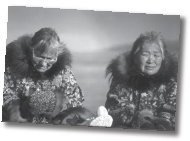History Talk Groups
History Talk Groups are designed to allow small groups of people to respond to firsthand sources. The literacy group can break into small groups to discuss a written document, visual image, guest speaker, recording or artifact.
If there are a number of firsthand sources, you could create ‘resource centres’ – a series of tables that each contain one firsthand source and questions to guide the discussion. The small groups move from one ‘resource centre’ to the next exploring each of the firsthand sources. This process might take several days or a week, with each group visiting just one table a day and discussing the source found there.
You could pose open-ended questions like, “What surprised you?
”, “What did
you find interesting?
”, “What are your responses to this source material?
”
You could create a poster that includes a series of general questions to guide all discussions:
- What is the name or title of the document? What is the artifact called?
- When was it written, made, produced?
- Who wrote it or made it?
- What do you know about the writer or creator? What would you like to know about him or her?
- What perspective or bias is shown in the writing?
- How does the material fit into the history of the time period?
- Summarize the piece of writing or describe a visual image, recording or artifact.
- What does it mean? What is its purpose?
- What don’t you understand? What is confusing to you?
- Ask questions about the document, artifact, visual image or recording.
Group members could take roles: facilitator, recorder, source manager and reporter. The facilitator guides the group through the discussion; the source manager makes sure that everyone has the information or can read the document; the recorder writes down the comments of each person in the group; and the reporter makes an oral presentation to the whole literacy group about their discussion.

History Talk Groups provide a small intimate setting where learners can explore their feelings and ideas about the information contained in the sources.